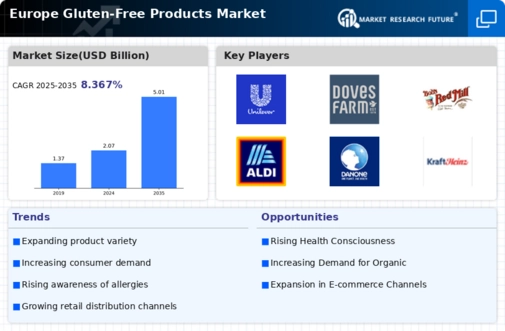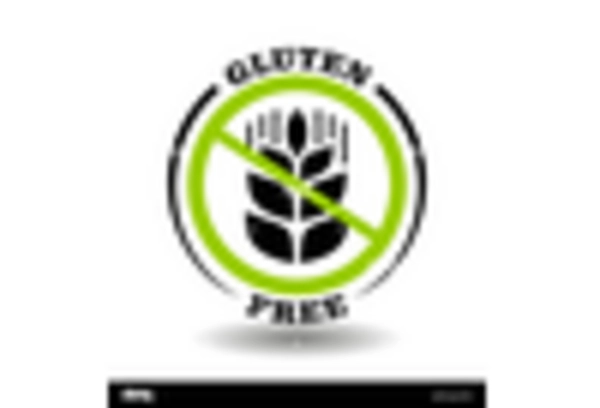Shifts in Dietary Preferences
The gluten free-products market is witnessing a significant transformation due to shifts in dietary preferences among consumers. Many individuals are opting for gluten free diets not solely for medical reasons but also for perceived health benefits. This trend is particularly pronounced among health-conscious consumers who associate gluten free products with improved digestion and overall well-being. Market data suggests that the gluten free-products market in Europe is projected to grow at a CAGR of around 9% over the next five years, driven by this shift in consumer behavior. As a result, food manufacturers are increasingly innovating and diversifying their gluten free offerings to cater to this expanding demographic, further propelling the market forward.
Expansion of E-commerce Platforms
The gluten free-products market is experiencing a notable boost due to the expansion of e-commerce platforms across Europe. With the increasing reliance on online shopping, consumers are finding it more convenient to purchase gluten free products from the comfort of their homes. E-commerce platforms provide a wider selection of gluten free items, often at competitive prices, which appeals to a broader audience. Recent data indicates that online sales of gluten free products have surged by over 30% in the past year, reflecting a shift in consumer purchasing habits. This trend is likely to continue, as more consumers embrace the convenience of online shopping, thereby driving growth in the gluten free-products market.
Increased Awareness of Celiac Disease
The rising awareness of celiac disease among the European population has become a pivotal driver for the gluten free-products market. As more individuals are diagnosed with this autoimmune disorder, the demand for gluten free options has surged. Reports indicate that approximately 1 in 100 people in Europe are affected by celiac disease, leading to a growing consumer base seeking gluten free alternatives. This heightened awareness not only influences purchasing decisions but also encourages food manufacturers to expand their gluten free product lines. Consequently, the gluten free-products market is experiencing a notable shift, with an increasing number of retailers dedicating shelf space to gluten free items, thereby enhancing visibility and accessibility for consumers.
Rising Demand for Clean Label Products
The gluten free-products market is significantly influenced by the rising demand for clean label products among European consumers. As consumers become more discerning about food ingredients, they are increasingly seeking transparency in product labeling. This trend is evident in the gluten free segment, where consumers prefer products that are not only gluten free but also free from artificial additives and preservatives. According to recent surveys, nearly 70% of European consumers express a preference for clean label products, which has prompted manufacturers to reformulate existing products and develop new gluten free options that align with these consumer expectations. This shift towards clean labeling is likely to enhance the credibility and appeal of gluten free products in the market.
Influence of Social Media and Health Trends
The gluten free-products market is significantly shaped by the influence of social media and emerging health trends. Social media platforms serve as powerful tools for disseminating information about gluten free diets, with influencers and health advocates promoting the benefits of gluten free living. This has led to an increase in consumer interest and curiosity regarding gluten free products. Furthermore, health trends that emphasize clean eating and natural ingredients are gaining traction, encouraging consumers to explore gluten free options. Market analysis suggests that the visibility of gluten free products on social media is likely to enhance brand recognition and consumer engagement, ultimately contributing to the growth of the gluten free-products market.

















Leave a Comment